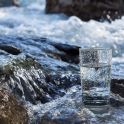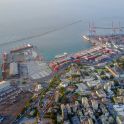
Improving radiation protection in interventional radiology
What measures can help to reduce radiation exposure?
The interdisciplinary team of scientists has therefore investigated the question of how high the exposure of personnel is and what measures can help to reduce radiation exposure. In addition to scientists from GRS, researchers from Augsburg University Hospital, Cologne University Hospital and Mirion Technologies Dosimetry Service were also involved.
They were able to build on the results of a previous project: At that time, a three-dimensional simulation model was developed using Monte Carlo simulations, which can determine the exposure of personnel and allow conclusions to be drawn for the optimisation of radiation protection.
Training video produced for medical personnel
The team was able to visualise the data and geometry from these simulations using the VIRTUS software - so well that they decided to produce not just individual animations, but a complete video from these sequences, that is aimed at medical personnel, radiation protection experts, medical physicists and other interested groups.
The individual sequences can be discussed as part of radiation protection training or within a team in order to optimise behaviour patterns and movement sequences during interventional measures from a radiation protection perspective and to improve the general understanding of the distribution of radiation in the room.
Excel tool for analysing individual assignments and personnel planning
In addition to the video, the scientists have developed an Excel tool that can be used, among other things, to analyse the personal radiation exposure of medical personnel in the intervention room over longer periods of time. This calculation tool can calculate the parameters of a specific interventional procedure as well as typical interventional procedures. For example, the effectiveness of radiation protection equipment or personal protective equipment can be determined. The tool can be used to analyse personal interventions, but also for personnel planning.
The Excel tool is available for free download in the download container at the right top of this page. The Excel file contains instructions. If you have any difficulties using the tool, please contact info@grs.de.
Project highlights Radiation Protection

GRS scientists have investigated in a research project funded by the Federal Ministry for the Environment how radon at the workplace can be measured and how its dispersion in buildings can be modelled.

In the project, the GRS research team developed a central database for all information on water supply facilities in Germany that is relevant for radiation protection.

On 4 August 2020, a devastating explosion occurred in the port of Beirut, the cause of which was the improper storage of chemicals. After Germany had already supported Lebanon in the management of chemicals in the aftermath of this explosion, the Lebanese authorities approached Germany with an additional request for support in the retrieval and safe storage of radioactive waste. Within the framework of a cooperation project funded by the Federal Ministry for the Environment (BMUV), the responsible Lebanese authorities are supported by experts from the BMUV and an interdisciplinary GRS team from the departments Radiation Protection and Security.